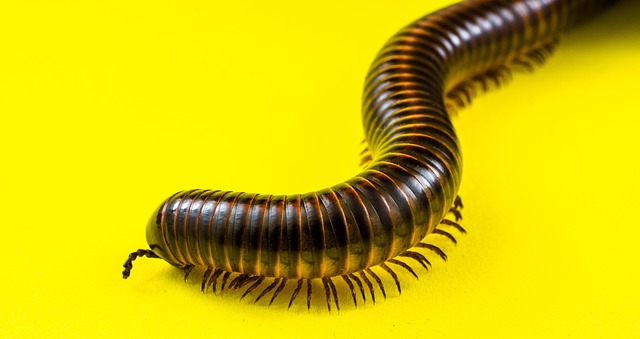Millipedes, drawn to damp environments and organic matter, infiltrate homes through cracks and unscreened openings. Eco-friendly millipede control involves understanding their behavior and implementing strategies like sealing gaps, regular cleaning, and using safe, natural repellents like neem oil and diatomaceous earth. Preventative measures, such as outdoor lighting and garden maintenance, deter infestation and promote a pet- and child-safe living environment.
Millipedes, though fascinating creatures, can become a nuisance when they invade homes and gardens. This article offers comprehensive child- and pet-safe millipede control plans, ensuring peace of mind for families and their furry friends. We’ll explore these strategies in detail, starting with understanding these tiny critters: their behavior, habitat preferences, and reproductive cycles. By implementing effective yet gentle methods, you can create a pest-free environment while maintaining ecological balance.
Understanding Millipedes: Behavior and Habitat
Millipedes are fascinating yet often misunderstood creatures that pose a common nuisance for homeowners, especially in damp environments. Understanding their behavior and habitat is crucial when developing child- and pet-safe millipede control plans. These nocturnal insects prefer cool, moist places, making their way into homes through cracks, gaps, or unscreened doors and windows during the warmer months. They are attracted to organic matter, so areas with high humidity, such as basements, bathrooms, and kitchens, are particularly vulnerable. Millipedes don’t travel far from their hiding spots but can quickly multiply, leading to an increasing presence within a home. By identifying their preferred habitats and understanding their behavior, homeowners can implement effective yet safe strategies to manage and prevent millipede infestations.
Child-Safe Approaches to Millipede Control
When it comes to millipede control, ensuring safety is paramount, especially in homes with children and pets. For families seeking child-safe approaches, there are several eco-friendly methods that prove effective without posing risks. One popular strategy involves using neem oil, a natural repellent derived from the neem tree. This organic compound is non-toxic to humans but discourages millipedes by disrupting their growth and reproduction cycles. Another safe option is diatomaceous earth, a natural powder made from fossilized algae. Its abrasive texture damages the exoskeletons of millipedes, dehydrating them over time without harming other creatures or plants.
Implementing preventative measures can also be part of your child-safe millipede control plans. Regularly sweeping and vacuuming floors and corners where millipedes tend to hide helps remove them from living spaces. Sealing gaps around windows, doors, and pipes with caulk prevents these creatures from entering homes. Additionally, keeping outdoor areas well-lit, especially during the summer months when millipedes are most active, can deter them from congregating near entry points.
Pet-Friendly Solutions for Managing Millipede Infestations
Managing a millipede infestation can be challenging, especially when considering the safety of pets and children. However, there are pet-friendly solutions that offer effective millipede control plans. One approach is to utilize natural repellents like diatomaceous earth, which is safe for both animals and humans yet proves lethal to these pests. Diatomaceous earth disrupts the protective outer layer of millipedes, causing dehydration and eventual death.
Another pet-friendly method involves introducing beneficial insects such as spiders or certain species of ants that naturally prey on millipedes. This biological control approach not only helps manage the infestation but also promotes a balanced ecosystem within your home or garden. Additionally, regular cleaning and sealing entry points can significantly reduce millipede habitats, providing an integrated pest management strategy that is safe for everyone, including furry friends and young ones.
Preventative Measures: Long-Term Strategies for Millipede Management
Preventative measures are key in developing long-term strategies for millipede management. Regularly inspecting your home and property for signs of millipedes, such as small trails or clusters of these creatures, can help identify potential entry points. Sealing cracks and gaps around windows, doors, and other openings with caulk or weatherstripping creates physical barriers, preventing millipedes from entering. Maintaining a clean environment by promptly cleaning up spills, removing standing water, and securing food items in airtight containers reduces attraction to these insects.
Additionally, implementing garden practices like trimming grass and shrubs close to your home, clearing debris, and using organic repellents can deter millipedes from taking up residence in your outdoor spaces. Regularly treating areas known for millipede activity with eco-friendly insecticides or natural solutions like neem oil further complements these measures. These combined efforts not only control existing millipede populations but also significantly reduce the risk of future infestations, providing long-lasting protection for both homes and pets.
In conclusion, effective millipede control plans can be achieved through a combination of understanding their behavior and habitat, implementing child- and pet-safe methods, and adopting preventative measures. By choosing non-toxic solutions tailored to specific needs, families and pets can coexist harmoniously with these fascinating creatures while maintaining a pest-free environment.
